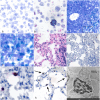Tissue and cellular tropism of Eptesicus fuscus gammaherpesvirus in big brown bats, potential role of pulmonary intravascular macrophages
- PMID: 38619093
- PMCID: PMC11264566
- DOI: 10.1177/03009858241244849
Tissue and cellular tropism of Eptesicus fuscus gammaherpesvirus in big brown bats, potential role of pulmonary intravascular macrophages
Abstract
Gammaherpesviruses (γHVs) are recognized as important pathogens in humans but their relationship with other animal hosts, especially wildlife species, is less well characterized. Our objectives were to examine natural Eptesicus fuscus gammaherpesvirus (EfHV) infections in their host, the big brown bat (Eptesicus fuscus), and determine whether infection is associated with disease. In tissue samples from 132 individual big brown bats, EfHV DNA was detected by polymerase chain reaction in 41 bats. Tissues from 59 of these cases, including 17 from bats with detectable EfHV genomes, were analyzed. An EfHV isolate was obtained from one of the cases, and electron micrographs and whole genome sequencing were used to confirm that this was a unique isolate of EfHV. Although several bats exhibited various lesions, we did not establish EfHV infection as a cause. Latent infection, defined as RNAScope probe binding to viral latency-associated nuclear antigen in the absence of viral envelope glycoprotein probe binding, was found within cells of the lymphoid tissues. These cells also had colocalization of the B-cell probe targeting CD20 mRNA. Probe binding for both latency-associated nuclear antigen and a viral glycoprotein was observed in individual cells dispersed throughout the alveolar capillaries of the lung, which had characteristics of pulmonary intravascular macrophages. Cells with a similar distribution in bat lungs expressed major histocompatibility class II, a marker for antigen presenting cells, and the existence of pulmonary intravascular macrophages in bats was confirmed with transmission electron microscopy. The importance of this cell type in γHVs infections warrants further investigation.
Keywords: Eptesicus fuscus; Patagivirus vespertilionid gammaherpesvirus 3; bats; chiroptera; gammaherpesvirus; pulmonary intravascular macrophage.
Conflict of interest statement
Declaration of Conflicting InterestsThe author(s) declared no potential conflicts of interest with respect to the research, authorship, and/or publication of this article.
Figures




Similar articles
-
Arousal from hibernation and reactivation of Eptesicus fuscus gammaherpesvirus (EfHV) in big brown bats.Transbound Emerg Dis. 2019 Mar;66(2):1054-1062. doi: 10.1111/tbed.13102. Epub 2018 Dec 26. Transbound Emerg Dis. 2019. PMID: 30554475
-
Isolation, characterization and prevalence of a novel Gammaherpesvirus in Eptesicus fuscus, the North American big brown bat.Virology. 2018 Mar;516:227-238. doi: 10.1016/j.virol.2018.01.024. Virology. 2018. PMID: 29407381
-
Detection of novel gammaherpesviruses from fruit bats in Indonesia.J Med Microbiol. 2018 Mar;67(3):415-422. doi: 10.1099/jmm.0.000689. Epub 2018 Feb 5. J Med Microbiol. 2018. PMID: 29458559
-
North American Big Brown Bats (Eptesicus fuscus) Harbor an Exogenous Deltaretrovirus.mSphere. 2020 Sep 23;5(5):e00902-20. doi: 10.1128/mSphere.00902-20. mSphere. 2020. PMID: 32968009 Free PMC article.
-
Detection of a novel herpesvirus from bats in the Philippines.Virus Genes. 2015 Aug;51(1):136-9. doi: 10.1007/s11262-015-1197-6. Epub 2015 May 9. Virus Genes. 2015. PMID: 25956292
Cited by
-
Herpesviruses: overview of systematics, genomic complexity and life cycle.Virol J. 2025 May 22;22(1):155. doi: 10.1186/s12985-025-02779-7. Virol J. 2025. PMID: 40399963 Free PMC article. Review.
References
Publication types
MeSH terms
Substances
LinkOut - more resources
Full Text Sources

